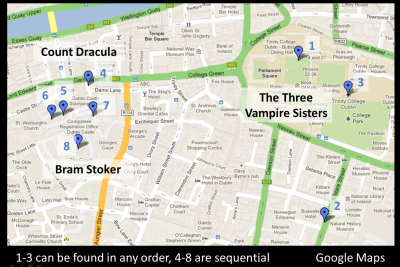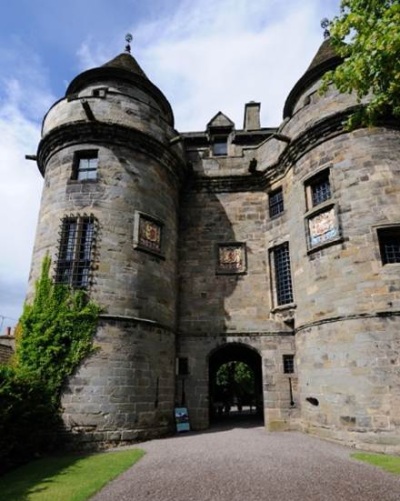In my last post, I discussed the location-based augmented-reality game Bram Stoker’s Vampires. I outlined the basic game concept and discussed how locations that were relevant to Stoker’s life as a student in Trinity College Dublin were used for geo-locating characters related to his novel Dracula. One of the characteristics of the game that I didn’t get to fully discuss in the first post is its narrative structure. I will do that in this post and I will also explain the flexibility in the narrative structure that our game engine affords.
Players of our games take on the roles of paranormal investigators, i.e., detectives who solve paranormal mysteries. For this reason, our basic narrative unit is a case (as in a case solved by a detective), which corresponds roughly to a quest, mission or level in many other games. A case typically takes 45-90 minutes to solve and should offer some degree of closure at the end. While the case is our main overarching narrative unit, it consists of smaller narrative parts, or encounters that are geo-located and linked together. During play, a player investigates one encounter at a time. Completing one encounter unlocks one or more in the chain. Our engine allows the encounters to be linked in a sophisticated fashion. The resulting experiences can be non-linear and personalized, such that different players playing together will get different experiences, which also improves replay value.
We distinguish between the following types of encounter structures:
- Sequential: One encounter is active. Completing the encounter unlocks the next.
- Parallel Inclusive: Multiple encounters are active and can be found in any order, but all must be completed to unlock the next.
- Parallel Exclusive: Multiple encounters are active and the player chooses a single one, which when completed eliminates the others.
The launch version of our game Bram Stoker’s Vampires contains a single case with a total of eight encounters. The first three encounters are the three vampire sisters that I introduced in the previous post, followed by four encounters with Count Dracula and one with Bram Stoker himself. We structured the encounters with the three sisters as a parallel inclusive structure, which means that the player can find them in any order. In game terms, this means that the player will see three blips on their paranormal radar and can choose which spot to investigate first. These parallel encounters are linked sequentially into the overall progression, meaning that the player must find all three sisters in order for the subsequent encounters (with Count Dracula) to be unlocked and the game to progress. As a narrative structure, this is a simple 3-way branching structure where the three paths join immediately. The figure below shows the map used for the launch version of the game that began on 26 October 2012 in collaboration with the Bram Stoker Festival.

The third possible structure, parallel exclusive, was not used in Bram Stoker’s Vampires. If encounters are linked in a parallel exclusive fashion, the player sees multiple blips on their radar and chooses one to investigate. When the chosen encounter has been completed, the remaining encounters (and corresponding radar blips) from the parallel set are removed from the radar. The player who sees multiple blips on their radar is not given any cues that will help them determine whether the next encounter is a parallel inclusive or exclusive and hence does not know whether the decision to investigate will eliminate the other encounters. What I call parallel exclusive in this post is the typical branching structure used in many interactive narratives: The player makes a decision that removes other possible story avenues at that point in time. (The branches may of course join again later on.)



References:
Katsiaryna Naliuka, Tara Carrigy, Natasa Paterson and Mads Haahr, ‘A Narrative Architecture for Story-Driven Location-Based Mobile Games,’ Springer LNCS, Third Workshop on Story-Telling and Educational (Serious) Games (STEG’10) , Shanghai, China, 8-10 December 2010.
Tara Carrigy, Katsiaryna Naliuka, Natasa Paterson and Mads Haahr, ‘Design and Evaluation of Player Experience of a Location-Based Mobile Game,’ 6th Nordic Conference on Human-Computer Interaction (NordiCHI 2010), Reykjavik, Iceland, October 16-20, 2010, pp 92–101.
